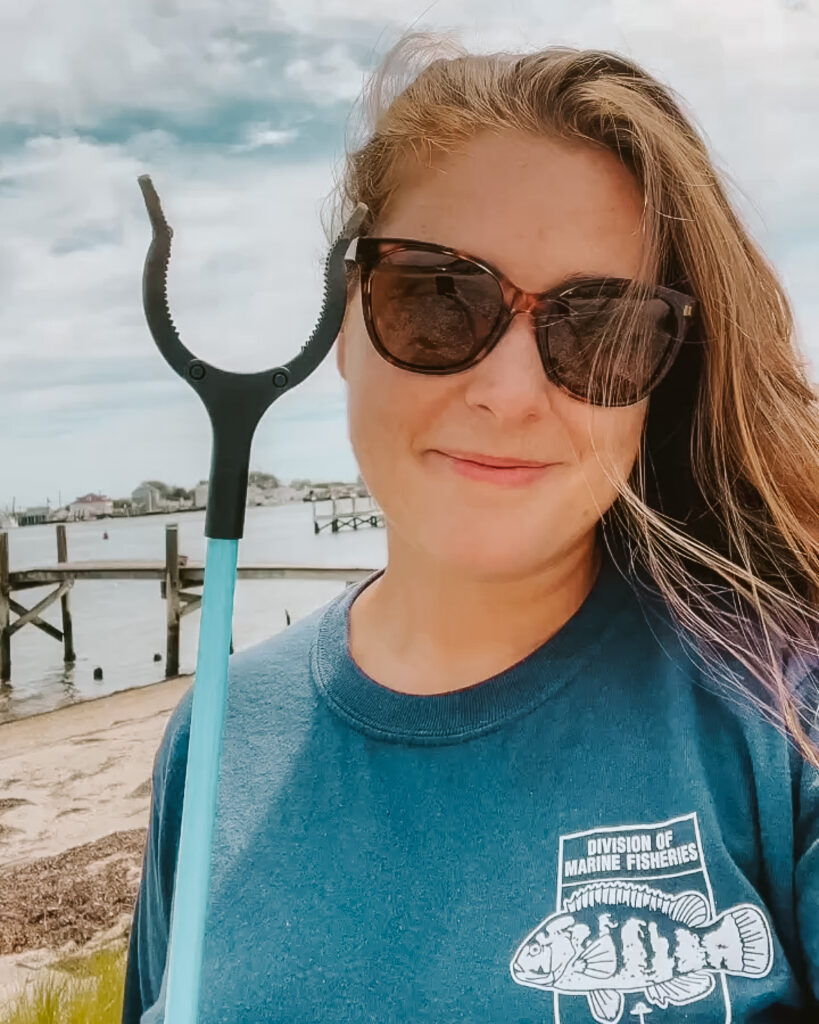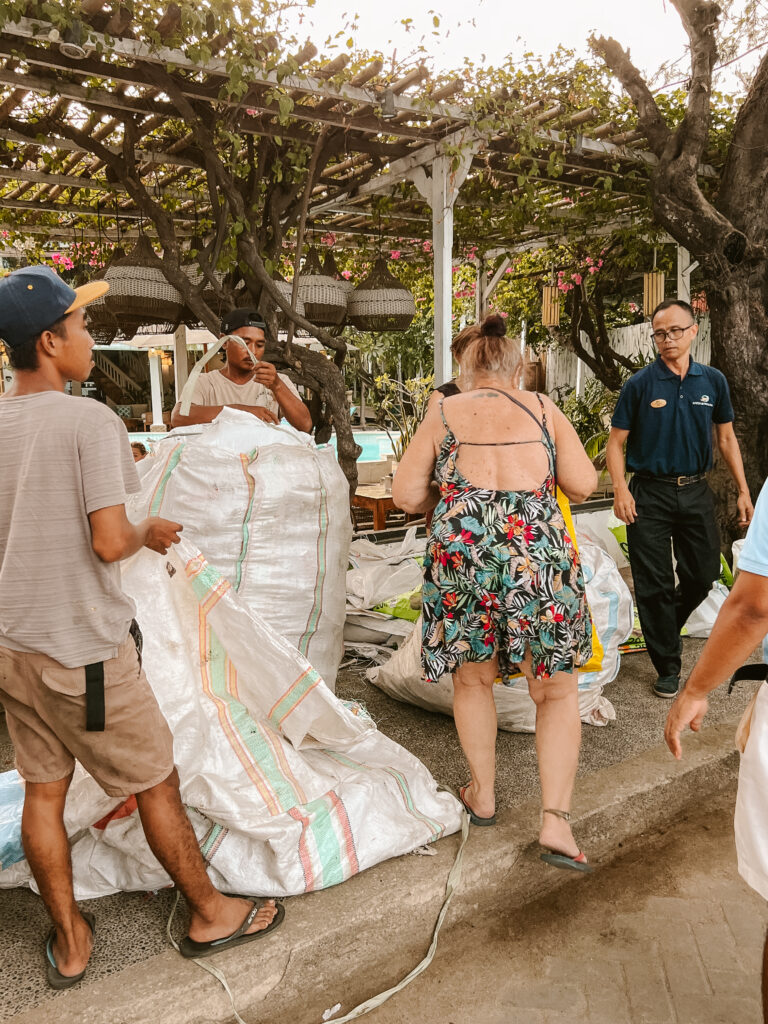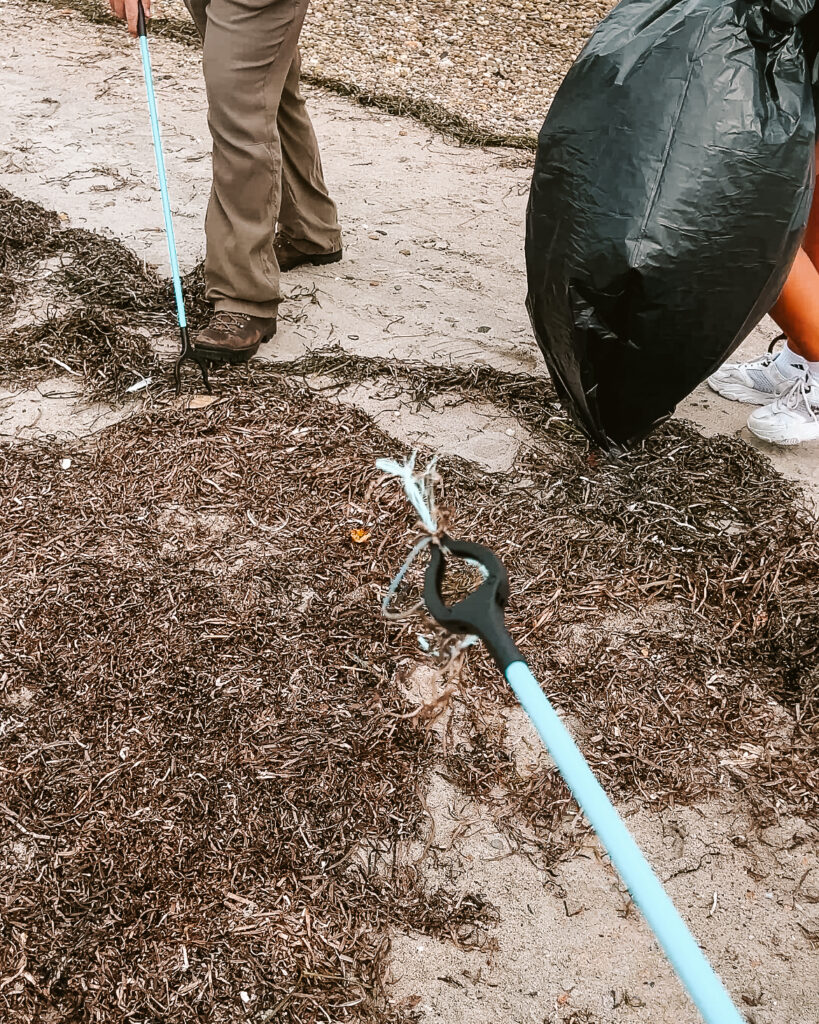How Beach Cleanups Help Protect the Marine Environment (and How to Get Involved!)
October 4, 2025

The other day, I took part in a beach cleanup with some of my colleagues. We’re so lucky that we have a little office/lab essentially on the beach, and all we had to do was step outside and do some trash collection. Team building + helping the environment, all in one. We found tons of things, from discarded fishing gear to bottles to cigarette butts, and more. As usual, it made me a little sick.
If you’ve ever taken a walk along the shoreline and spotted food wrappers, plastic bottles, or fishing line tangled in seaweed, you know what I’m talking about. Our oceans are drowning in plastic. Scientists estimate that 8–12 million tons of plastic enter the ocean every single year. That’s the equivalent of dumping a garbage truck full of waste into the sea every minute.
And that number is rising. By 2050, scientists warn there could be more plastic than fish (by weight) in the ocean if nothing changes. Ugh.
But here’s the hopeful part: you don’t need to be a marine scientist or policy maker to make a difference. One of the most powerful ways ordinary people can protect the ocean is through a beach cleanup.
The Problem: Marine Debris and Ocean Health
Marine debris comes from countless sources: litter dropped in cities that gets washed into rivers, plastic packaging that escapes landfills, abandoned fishing gear drifting at sea, and microplastics shed from our clothes.
Remember what Gill said in Finding Nemo? “All drains lead to the ocean.” Any pollution on land is at risk of ending up at sea thanks to coastal runoff. Once in the ocean, this debris causes far-reaching damage.
Marine life ingests the debris
Over 700 marine species from plankton to whales have been documented eating plastic. Sea turtles often mistake plastic bags for jellyfish, while seabirds ingest bottle caps and lighters. Tragically, some animals starve with stomachs full of plastic they cannot digest. This photo of an albatross chick is famous because it paints such a stark picture of what plastic is doing to wildlife.

Plastics cause entanglement hazards
Fishing nets, ropes, six-pack rings, and more entangle marine animals. Once caught up in junk, movement is restricted, which causes injuries or leads to drowning. The World Animal Protection organization estimates that 640,000 tons of fishing gear are lost or abandoned in the ocean each year, known as “ghost gear.”
Habitats are at risk of damage
Coral reefs and seagrass beds can be smothered by debris. It can block sunlight and suffocate delicate ecosystems that countless species rely on. Beyond physical pollution like plastic, chemical runoff from industry, oil spills, and even noise pollution all weaken habitats. A reduction in ecosystem health directly correlates to a reduction in biodiversity and, in turn, resilience to climate change.

Marine debris poses risks to human health
Microplastics—tiny fragments of broken-down plastic—are now found in seafood, salt, drinking water, and even human blood. Does that freak anyone else out?!
The long-term health impacts of microplastics remain uncertain, but we all know it can’t be good. Early studies suggest it links to inflammation and hormone disruption. I’ve heard that the average adult eats about a credit card’s worth of plastic each week. Gosh, I hope that’s not true.
Marine debris also carries an economic cost
Tourism suffers when beaches are littered with trash. Coastal communities spend billions annually on cleanup. According to the UN, the global economic damage caused by ocean plastic pollution is at least $13 billion per year. Especially in developing countries or places heavily reliant on tourism, this is bad news.

Why Beach Cleans Make a Difference
It may feel like a drop in the ocean (lol) but picking up trash on your local beach is far more impactful than it seems. Here’s why:
Beach cleans stop pollution at the shoreline
Every piece of litter removed prevents it from breaking down into microplastics and circulating into the wider ocean. Or, if that pollution came from the ocean, picking it up prevents it from returning.
Did you know that a single plastic bottle can take 450 years to decompose? Your great-great-great-grandkids will be adults and that bottle will still be kicking around in the environment. By removing it today, you’re preventing centuries of harm.
They support scientific research
Many cleanup organizations collect data on the type and amount of trash collected. For example, the International Coastal Cleanup (ICC) has gathered 35 years of global data, revealing that the most common items are cigarette butts, food wrappers, plastic bottles, straws, and plastic bags. This data guides laws and bans on single-use plastics.
The Clean Swell® app, created by Ocean Conservancy, is the best way to submit your data so scientists can use it in research. As you collect trash, you can log every item you collect. This data goes into a global database that helps scientists and policymakers better understand marine debris trends and create smarter solutions to tackle the problem at its source. Heck yes, citizen science.
They build community awareness
Seeing neighbors, families, and schools work together on a beach cleanup sparks conversations and inspires behavior changes. It turns the issue into a shared mission that anyone can get involved with.
They influence policy and corporate responsibility
Never underestimate the power of grassroots movements to drive significant policy changes. Beach cleanup data helped support plastic bag bans in over 90 countries and restrictions on straws and polystyrene in dozens more. Let’s keep that going.

They create a sense of stewardship
Beyond the environmental impact, beach cleans connect people to their local coastline, strengthening the bond between communities and the marine environment. If you’ve ever lived by the sea, you know how valuable this is.
Getting Involved in a Beach Clean
Are you motivated to get involved yet? Let’s get going.
Join organized events
Groups like Ocean Conservancy, Surfrider Foundation, Keep America Beautiful, and 4Ocean host regular cleanups. Many dive shops also organize “Dive Against Debris” events where divers remove litter directly from the seafloor.

Another place to find organized beach cleans is on Facebook events. Just do a quick search for events in your area and see what pops up.
Start your own community cleanup
Gather a small group of friends or colleagues. All you need are gloves, reusable bags or buckets, and a safe disposal plan. Some municipalities may require permits for larger groups, so make sure you look into that.
Practice safety first
Always wear gloves or use a trash pick-up stick. Avoid sharp or hazardous items, and never pick up heavy debris alone. Report large or dangerous waste (such as oil drums) to local authorities.
Separate the recyclables
Have a separate bag or bucket for trash and another for recyclables. Make sure you know what’s recyclable and what isn’t. WM’s Recycling Guide is a great resource.
Make it fun and engaging
Turn it into a family outing, a school project, or even a team-building event for your workplace like we did. Even a small, quick cleanup can remove pounds of trash from your local environment.

Beyond the Clean-Ups towards Lasting Impact
The sad reality is that beach cleans can be like a band-aid on a flesh wound if we don’t simultaneously tackle the problem at the source. We have to deal with the debris that already exists in the marine environment while cutting it off at the source at the same time.
Here are a few things you can do to help that process!
Refuse single-use plastics when possible
Carry a reusable water bottle, coffee cup, straw, and shopping bag. These things are quite basic and often easy. I never leave home without my reusable water bottle, for example. I’ll refuse a plastic straw, sure, but remember that these types of actions are usually more symbolic than they are impactful. Look for little things you can do to be more sustainable each day.

Reduce packaging waste
Shop at bulk stores, buy unpackaged produce, and choose products with minimal plastic. This isn’t always possible, but just do the best you can. Eco-worry is real. Be kind to yourself.
Support sustainable businesses
Look for companies that use compostable, recycled, or reusable packaging. Nearly every purchase decision I make goes through the “is this sustainable?” question. I do the best a mere mortal such as me can.
Advocate for stronger policies
While you’re feeling guilty for throwing away that plastic granola bar wrapper (anyone?), there are massive corporations polluting both our lands and oceans without shame. Yes, be eco-conscious, but realize that mostly, it’s not you who’s the problem. It’s the big guys. And they avoid responsibility by putting the blame on you.
Let’s hold them accountable. Write to local representatives about plastic bans and improved recycling systems. Call your congresspeople and tell them you’ve had enough with marine pollution. Ask them what their plans are to ensure our beaches stay clean.
Educate and inspire others
Share your cleanup experiences on social media. Visibility creates momentum for change. Encourage your friends to join you next time. Let’s make picking up trash cool, friends!
Remember that marine conservation doesn’t stop when you leave the beach. It continues in your daily habits. Each one of us can make a difference every day.
The Double-Edged Sword of Plastic
It’s important to remember that plastic itself isn’t the villain. Lightweight and durable, plastic has made healthcare safer (think sterile syringes, IV bags, and protective gloves), reduced food waste through better packaging, and even lowered transportation emissions by making cars and planes lighter. In many cases, plastic has replaced materials like glass or metal, cutting costs and improving accessibility.
In grad school, I listened to a presentation from a woman who was doing her PhD on plastic pollution in the marine environment. One quote I’ll never forget she said was, “I wouldn’t want to live in a world without plastic.” It shocked me at the time, but we have to remember all the benefits plastic provides.
The problem isn’t plastic itself. It’s how we use and dispose of it. Single-use items, poor waste management, and overproduction have turned a valuable material into a global pollution crisis. Striking a balance between human progress and environmental protection is absolutely key.
Inspiring Success Stories of Beach Clean-ups
You might feel like a simple beach clean doesn’t have much impact. Luckily, there is plenty of evidence that this isn’t the case.

In 2023, volunteers in the International Coastal Cleanup removed over 5 million pounds of trash from coastlines and waterways across 150 countries. In particular, the Philippines has had great success with this program. There, youth-led organizations have combined cleanup events with educational campaigns that reduce local plastic use in schools and businesses.
In India, the Versova Beach cleanup led by lawyer Afroz Shah and thousands of volunteers removed more than 20 million kilograms of waste over two years. The transformation was so dramatic that nesting sea turtles returned to the beach for the first time in decades.
Finally, 4ocean, one of my favorite charities, is a company dedicated to ending the ocean plastic crisis. They’ve removed over 30 million pounds of trash from the ocean and coastlines since 2017. Through the sale of bracelets and other products, they fund global cleanup operations, proving that a business model can successfully combine consumer action with large-scale environmental impact.
These examples show how small-scale, local action can snowball into global change. As an optimistic environmentalist, this is one of my core beliefs.
Protecting Oceans One Beach at a Time
Beach cleanups are about far more than trash collection. They are about protecting marine life, inspiring communities, and building a movement toward healthier oceans.
The next time you head to the coast, bring gloves and a bag along with your sunscreen. Better yet, find a local event and join others who care about protecting our seas.
Every bottle, every wrapper, and every fishing line picked up is one step closer to a cleaner, healthier ocean. And when millions of people take those steps together, we can turn the tide against plastic pollution.
Now it’s your turn to take action! Find an event through Ocean Conservancy’s International Coastal Cleanup or connect with local organizations in your community. Together, we can tackle ocean pollution one beach at a time.
Hey! Don’t forget to make your cleanup count! Use the free Clean Swell® app to log the trash you collect and contribute to global ocean research with each piece you pick up.
References
Ellen MacArthur Foundation, World Economic Forum, & McKinsey & Company. (2016). The new plastics economy: Rethinking the future of plastics. https://www.ellenmacarthurfoundation.org/publications/the-new-plastics-economy-rethinking-the-future-of-plastics
Hindustan Times. (2022, August 21). Beach warriors to the rescue: Versova beach throws up 9.5 mt of garbage after 4 years. Hindustan Times. https://www.hindustantimes.com/cities/mumbai-news/beach-warriors-to-the-rescue-versova-beach-throws-up-9-5mt-of-garbage-after-4-years-101661097849488.html Hindustan Times
Hindustan Times. (2018, August 3). 3 years, 20 million kg trash later, Versova beach clean-up crusader looks for new mission. Hindustan Times. https://www.hindustantimes.com/mumbai-news/3-years-20-million-kg-trash-later-versova-beach-clean-up-crusader-looks-for-new-mission/story-Y0tJA0ZRWfUFRXGFLUe7yL.html Hindustan Times
Jambeck, J. R., Geyer, R., Wilcox, C., Siegler, T. R., Perryman, M., Andrady, A., Narayan, R., & Law, K. L. (2015). Plastic waste inputs from land into the ocean. Science, 347(6223), 768–771. https://doi.org/10.1126/science.1260352
Manomet Conservation Sciences. (2023). International Coastal Cleanup Day: Local Event with Global Impact. Manomet. https://www.manomet.org/publication/international-beach-cleanup-day-local-event-with-global-impact/ Manomet Conservation Sciences
Ritchie, H. (2019). Where does our plastic accumulate in the ocean and what does that mean for the future? Our World in Data. https://ourworldindata.org/where-does-plastic-accumulate
United Nations Environment Programme. (2025). Plastic pollution. https://www.unep.org/plastic-pollution
World Economic Forum. (2016). More plastic than fish in the ocean by 2050: Report offers blueprint for change. https://www.weforum.org/press/2016/01/more-plastic-than-fish-in-the-ocean-by-2050-report-offers-blueprint-for-change/